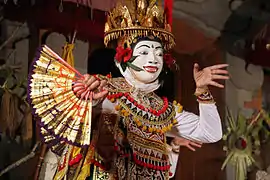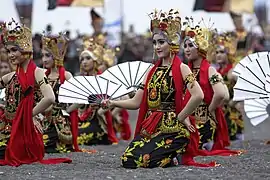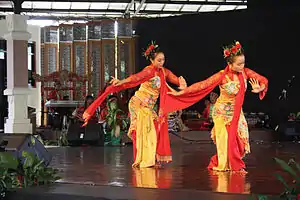Bambangan Cakil
Bambangan Cakil (Javanese: ꦧꦩ꧀ꦧꦔꦤ꧀ꦕꦏꦶꦭ꧀, romanized: Bambangan Cakil; Pegon: بمبڠن چاكل) is a classical dance-drama[1] of Javanese people in—particularly—Central Java, Indonesia.[2] This dance-drama is demonstrates wayang performance due to the movement is adopted from one of the scenes in wayang kulit performance, that is the Perang Kembang scene.[3] The Perang Kembang told about war between kesatria against raksasa. The kesatria has soft and gentle-characters, while the raksasa described as character who is rough and violent.
 Bambangan Cakil performance | |
| Origin | Indonesia |
|---|---|
The dance-drama war[4] between kesatria (Bambangan) against raksasa (Cakil) could also be used as a place for a dalang's judgment in moving a puppet.
Philosophy
In Javanese culture, kesatria always considered as a good figures, willing to defend the truth, to help others, etc.[5] The kesatria title is given not because heredity. For example, in the Mahabharata story, Kurawa does not has a kesatria title, even though he has the same ancestors as the Pandava.
In other hand, raksasa is a rough, violent and dynamic-character.
Characterizations
In the Bambangan Cakil dance-drama, Arjuna depicted as kesatria, while Cakil depicted as raksasa.[6]
References
- Widiarto, Bambang. "Tari Klasik"Bambangan Cakil"". Retrieved 30 October 2020. Cite journal requires
|journal=(help) - "Tari Bambangan Cakil Tarian Tradisional dari Jawa Tengah". Negeriku Indonesia. Retrieved 30 October 2020.
- Murtiyoso (2009). Perang Kembang dan Bambangan-Cakil "Tontonan Bermakna Ganda". Surakarta: ISI Press.
- Handayani, Langlang; Prasetya Aji, Mahardika; Susilo; Marwoto, Putut (2016). "Bringing Javanesse Traditional Dance into Basic Physics Class: Exemplifying Projectile Motion through Video Analysis". Journal of Physics Conference Series. 739 (1): 012073. Bibcode:2016JPhCS.739a2073H. doi:10.1088/1742-6596/739/1/012073. Retrieved 30 October 2020.
- Murtiyoso (2004). Pertumbuhan dan Perkembangan Seni Pertunjukan Wayang. Surakarta: ISI Press.
- "Tari Bambangan Cakil". Dinas Kearsipan dan Perpustakaan Provinsi Jawa Tengah. Retrieved 30 October 2020.

.svg.png.webp)





